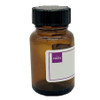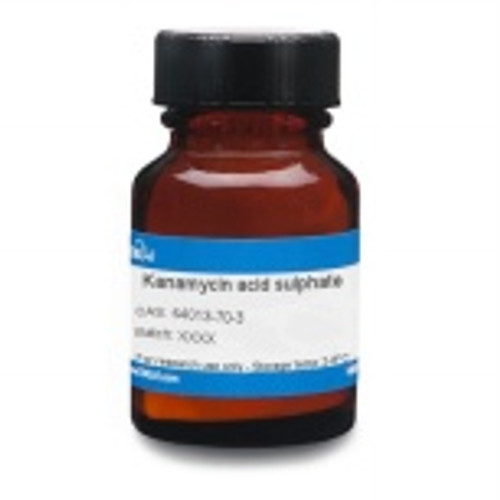Kanamycin Acid Sulfate, for BioProcessing is an aminoglycoside antibiotic that has been optimized for bioprocessing applications including biofuel production. The product is commonly used as a selective agent to select for resistant mammalian, fungal, or bacterial cells that contain the kanMX marker or other kanamycin resistance genes.
Kanamycin Acid Sulfate, for BioProcessing is soluble in water.
We also offer:
- Kanamycin Sulfate, USP (K008)
- Kanamycin Acid Sulfate, EP (K029)
- Kanamycin Acid Sulfate, EW, CulturePure® (K029)
- Kanamycin A Sulfate, EvoPure® (K013)
- Kanamycin B sulfate, EvoPure® (K014)
| Mechanism of Action |
Aminoglycosides target the 30S ribosomal subunit, lodging between the 16S rRNA and S12 protein. This interferes with the translational initiation complex causing misreading of the mRNA, and production of a faulty or nonexistent protein. |
| Spectrum | Kanamycin is a broad spectrum antibiotic; however, it is mostly used against aerobic Gram-negative bacteria. |
| Microbiology Applications | Kanamycin Acid Sulfate is commonly used as a selective agent to select for resistant mammalian, fungal, or bacterial cells that contain the kanMX marker or other Kanamycin resistance genes. Kanamycin Acid sulfate is typically used at a concentration of 50 µg/mL.
Media SupplementsKanamycin can be used as a selective agent in several types of isolation media: Kanamycin Aesculin Azide Agar - Enterococci isolation in food Perfringens Agar - SFP and TSC selective supplements for the isolation of Clostridium perfringens Kanamycin is commonly used in clinical in vitro microbiological antimicrobial susceptibility tests (panels, discs, and MIC strips) against Gram-positive and Gram-negative microbial isolates. Medical microbiologists use AST results to recommend antibiotic treatment options. Kanamycin is one of the most widely used antibiotics yet its biosynthetic pathway remains unclear. Authors reconstructed the entire biosynthetic pathway through the expression of putative biosynthetic genes from S. kanamyceticus in the non-aminoglycoside-producing Streptomyces venezuelae, demonstrating the potential of pathway engineering to direct in vivo production of more robust aminoglycosides (Park et al, 2011). Bacterial fermentations using a microbioreactor with a volume of microliters is made of poly (dimethylsiloxane) and glass. Bacterial fermentations are compared to results in a 500-ml bench-scale bioreactor and the behavior is similar, thus it can be used to model different physiological states for bioprocessing using Kanamycin selection (Zanzotto et al, 2004). Consolidated bioprocessing (CBP) of lignocellulosics by Fusarium oxysporum was studied for bioethanol productivity using Agrobacterium tumefaciens transformation using a Kanamycin selection system. Engineered transformants produced approximately 60% more ethanol compared to wild-type (Anasontzis et al, 2011). |
| Plant Biology Applications | Kanamycin is often used in the Agrobacterium mediated transformation while using the npt II gene as selection marker. Kaur and Bansal (2010) used Kanamycin in combination with cefotaxime to control bacterial growth while transforming tomatoes.
Microbial cellulosic utilization makes use of Kanamycin in gene selection for purpose of bioprocessing of cellulosic biomass for conversion into biofuels. Strategies include engineering naturally occurring microorganisms to improve yield/titer, or engineering non-cellulolytic organisms to express a heterologous cellulase system (Lynd et al, 2005). Caldicellulosiruptor bascii is a thermophilic anaerobic bacterium that can deconstruct non-pretreated lignocellulosic plant biomass and is the most thermophilic cellulose degrader known. It is of interest in genetic engineering applications for biofuel production. A thermostable Kanamycin resistance gene (Cbhtk) was used in the study. A selection system was developed using Kanamycin that can be used to efficiently delete genes, with the goal of producing a thermostable version of lactate dehydrogenase (Lipscomb et al, 2016). |
| Molecular Formula | C18H36N4O11 · 2 H2SO4 |
| References |
Pryjma, et al. used Kanamycin Sulfate (TOKU-E) to select for transformed Kanamycin-resistant Campylobacter jejuni cells: "FdhTU-modulated formate dehydrogenase expression and electron donor availability enhance recovery of Campylobacter jejuni following host cell infection" Aragão FJL and Brasileiro ACM (2009) Positive, negative and marker-free strategies for transgenic plant selection. Braz. J. Plant Physiol. 14(1):1-10 Davis, BD (1987) Mechanism of bactericidal action of aminoglycosides. Microbiol. Rev. 51(3):341-350 Lipscomb GL et al (2016) A highly thermostable Kanamycin resistance marker expands the tool kit for genetic manipulation of Caldicellulosiruptor bescii. Appl. Environ. Microbiol. 82 (14): 4421-4428 Lynd LR, van Zyl WH, McBride JE and Laser M (2005) Consolidated bioprocessing of cellulosic biomass: An update. Curr. Opin. Biotechnol. 16(5):577-583 Park JW et al (2011) Discovery of parallel pathways of Kanamycin biosynthesis allows antibiotic manipulation. Nat. Chem. Biol. 7(11):843-852 PMID 21983602 Zanzotto A et al (2004) Membrane-aerated microbioreactor for high-throughput bioprocessing. Biotechnol. Bioeng. 87(2):243-254 |
| MIC | Bacillus subtilis| 3.9| Candida albicans| 2000| Escherichia coli| 31.2| Salmonella Enteritidis| 62.5| Staphylococcus aureus| 31.2| |







